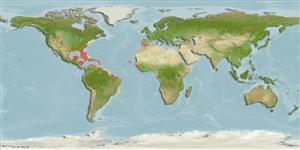>
Tetraodontiformes (Puffers and filefishes) >
Monacanthidae (Filefishes)
Etymology: Cantherhines: Greek, kanthos = the outer or inner corner of the eye, where the lids meet, 1646 + Greek, rhinos = nose (Ref. 45335).
Environment: milieu / climate zone / depth range / distribution range
Sinh thái học
Biển Cùng sống ở rạn san hô; Mức độ sâu 3 - 50 m (Ref. 3592), usually 3 - 20 m (Ref. 40849). Subtropical; 42°N - 26°S, 98°W - 10°E
Western Atlantic: Massachusetts (USA), Bermuda, and northern Gulf of Mexico to southeastern Brazil. Eastern Atlantic: São Tomé, Gulf of Guinea (Ref. 3592).
Bộ gần gũi / Khối lượng (Trọng lượng) / Age
Maturity: Lm ? range ? - ? cm
Max length : 20.0 cm TL con đực/không giới tính; (Ref. 7251); common length : 14.0 cm TL con đực/không giới tính; (Ref. 3592)
Các tia vây lưng cứng (tổng cộng) : 2; Các vây lưng mềm (tổng cộng) : 33 - 36; Tia cứng vây hậu môn: 0; Tia mềm vây hậu môn: 29 - 32. First dorsal spine originating over center or front part of eye and followed by a deep groove into which the spine can fold; body with small scattered orange spots, many of which have brown centers, and whitish spots of same size; dull yellow lines on head which run towards snout, those near eye alternating with bluish lines (Ref. 13442).
Found in shallow water and around coral and rocky reefs (Ref. 3790). Usually remains near the bottom, hiding among gorgonians and branching coral (Ref. 9710). Feeds on bottom growth, primarily sponge and algae, but stomach often contain tunicates, bryozoans and other sessile benthic invertebrates (Ref. 5521). The young are pelagic and highly important food items in the diet of large predaceous fishes such as tunas and billfishes (Ref. 3790). Generally considered as trash fish, rarely consumed (Ref. 3790).
Life cycle and mating behavior
Maturities | Sự tái sinh sản | Spawnings | Egg(s) | Fecundities | Ấu trùng
Robins, C.R. and G.C. Ray, 1986. A field guide to Atlantic coast fishes of North America. Houghton Mifflin Company, Boston, U.S.A. 354 p. (Ref. 7251)
IUCN Red List Status (Ref. 130435)
Threat to humans
Reports of ciguatera poisoning (Ref. 30303)
Human uses
Các nghề cá: Các nghề cá là sinh kế; Bể nuôi cá: Tính thương mại
Các công cụ
Special reports
Download XML
Các nguồn internet
Estimates based on models
Preferred temperature (Ref.
123201): 23.4 - 28, mean 26.4 °C (based on 402 cells).
Phylogenetic diversity index (Ref.
82804): PD
50 = 0.5002 [Uniqueness, from 0.5 = low to 2.0 = high].
Bayesian length-weight: a=0.02188 (0.01256 - 0.03811), b=2.88 (2.72 - 3.04), in cm total length, based on LWR estimates for this species & (Sub)family-body (Ref.
93245).
Mức dinh dưỡng (Ref.
69278): 2.6 ±0.1 se; based on diet studies.
Thích nghi nhanh (Ref.
120179): Chiêù cao, thời gian nhân đôi của chủng quần tối thiểu là dưới 15 tháng (Preliminary K or Fecundity.).
Fishing Vulnerability (Ref.
59153): Low vulnerability (10 of 100).
Nutrients (Ref.
124155): Calcium = 26.9 [4.9, 86.5] mg/100g; Iron = 0.924 [0.313, 2.627] mg/100g; Protein = 18.6 [16.3, 20.8] %; Omega3 = 0.125 [0.057, 0.285] g/100g; Selenium = 20.4 [7.1, 61.8] μg/100g; VitaminA = 37.8 [8.8, 168.8] μg/100g; Zinc = 1.4 [0.6, 2.5] mg/100g (wet weight);
